The Top 20 NBA Draft Prospects in the Pac-12 Conference
The Top 20 NBA Draft Prospects in the Big 12 Conference
The Top 10 NBA Draft Prospects in the AAC Conference
The Top 22 NBA Draft Prospects in the SEC Conference
The Top 10 NBA Draft Prospects in the Big East Conference
The Top 20 NBA Draft Prospects in the Big Ten Conference
The Top 26 NBA Draft Prospects in the ACC Conference
Top NBA Prospects in the Non-BCS Conferences, Part One
(#1) R.J. Hunter (Scouting Video)
Top NBA Prospects in the Non-BCS Conferences, Part Two
(#2) Rashad Vaughn (Scouting Video)
Top NBA Prospects in the Non-BCS Conferences, Part Three
(#3) Domantas Sabonis (Scouting Video)
Top NBA Prospects in the Non-BCS Conferences, Part Four
(#4) Shawn Long (Scouting Video)
Top NBA Prospects in the Non-BCS Conferences, Part Five
(#5) E.C. Matthews (Scouting Video)
Top NBA Prospects in the Non-BCS Conferences, Part 6
(#6) Ron Baker
(#7) Fred VanVleet
(#8) Keifer Sykes
(#9) Briante Weber
Top NBA Prospects in the Non-BCS Conferences, Part 7
(#10) Przemek Karnowski
(#11) Alan Williams
(#12) Christian Wood
(#13) Treveon Graham
Top NBA Prospects in the Non-BCS Conferences, Part 8
(#14) Mamadou Ndiaye
(#15) Vince Hunter
(#16) Joel Bolomboy
(#17) Larry Nance
Top NBA Prospects in the Non-BCS Conferences, Part 8
(#14) Mamadou Ndiaye
(#15) Vince Hunter
(#16) Joel Bolomboy
(#17) Larry Nance
Top NBA Prospects in the Non-BCS Conferences, Part 9
(#18) Speedy Smith
(#19) Cameron Payne
(#20) Alex Hamilton
(#21) Luke Nelson
#22 DeAndre Bembry, 6'6, Small Forward, St. Joseph's, Sophomore
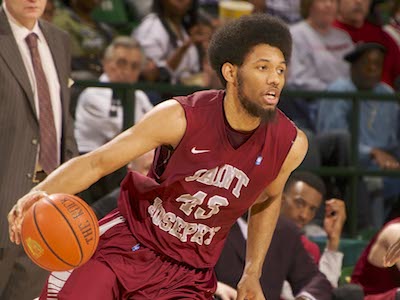
Derek Bodner
DeAndre Bembry was a pleasant surprise for Phil Martelli and the St. Joseph's Hawks last season, starting every game on an experienced team while chipping in 12.1 points and 4.5 rebounds per night. Bembry, who's 34 games started as a freshman were the most in Hawks history, would earn the A-10 Co-Rookie of the year along with Rhode Island's E.C. Matthews.
Heading into his second season, Bembry will have a much different role, both in the locker room and on the basketball court. With the loss of Langston Galloway and Ronald Roberts Jr. to graduation, St. Joseph's lost not only a lot of their scoring punch but also much of their leadership and experience. Beyond carrying an increased scoring load, Bembry will be a co-captain for the Hawks this season, the first sophomore to be chosen as a captain in Phil Martelli's 20 seasons with St. Joseph's.
Playing much of his high school career inside, the 6'6 Bembry successfully made the transition to the perimeter last season. He connected on 34.6% of his 3.1 three point attempts per game last season, improving on his consistency as the season went on, including an 11 game stretch in February and March where he connected on 1.6 three pointers per game at a 46.1% clip.
The overall form on Bembry's set shot doesn't look like it needs too much refinement, although his release point can become inconsistent when he's rushed. Still, with time and repetition, it looks to be a good enough base that Bembry can make progress towards improving his consistency.
Bembry also shows some ability to create off the dribble. He doesn't have an incredibly explosive first step, but he's comfortable going in either direction, and uses a good combination of change of direction, pump fakes, and head fakes to get where he needs to go. Once into the lane, he's a solid leaper, but really makes mark with aggressive drives, where he has good body control and ability to play through contact. His willingness to play through contact and his aggressiveness in initiating contact can take defenders by surprise, and his 50% free throw rate helps him out in this regard, although the 58.3% he shoots from the line when he gets there leaves something to be desired.
Much of this also comes into play when he's playing off the ball, as he does a good job moving without the basketball, making hard cuts to the basket to get himself open. While Bembry is likely to have the ball in his hands more this upcoming season, continuing to show a good knack for cutting off the ball, while improving as a set shooter and showing more confidence shooting when coming off of screens would make it easier to envision his successful transition to the next level.
Bembry also shows some promise as a setup man, dishing out 3.4 assists per 40 minutes, pace adjusted. He does a good job of pushing the ball in transition, able to spot both guys filling the lanes and players trailing and camped beyond the three point line. He also does a good job reacting to defenses collapsing on him when he drives, as he's a willing passer who keeps his head up. Still, he can become turnover prone, with nearly as many turnovers as assists, frequently making risky passes while also getting air born a little too often.
Bembry's greatest asset might be on the defensive end, where he frequently guarded the opposition's best wing scorer. Making the most of his 6'6 frame and long arms, staying engaged on the perimeter, in a good defensive stance, and doing a good job of working hard to cut off driving lanes. He does struggle at times fighting through the pick and roll, and he can get caught cheating too far off his man when playing off the ball, giving up open jump shots. Still, he's already very much a productive defender at the collegiate level, and the basis is there for him to be a good defender at the next level as well.
At this point, Bembry is a bit of a jack of all trades, with an intriguing combination of size, outside potential, slashing ability, passing, and defensive tools. Still, the old adage of being a jack of all trades, master of none applies here, as he's not yet fully proficient enough in any one area to really feel confident in what he would be at the next level. If he can continue to hone his perimeter skills, becoming more confident in both his set shot and his ability to connect off the dribble, Bembry could garner of attention from NBA scouts come draft time.
#23 Dyshawn Pierre, 6-6, Shooting Guard, Dayton, Junior
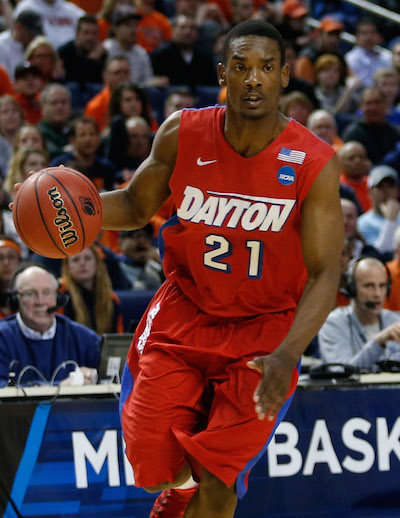
Josh Riddell
A lightly recruited player from Canada, Dyshawn Pierre turned heads as a 17 year old at the U-19 World Championships, which helped him land at Dayton. Pierre returns to Dayton for his junior season hoping to help the Flyers back to the NCAA tournament after their run to the Elite Eight.
Pierre is an excellent three point shooter, shooting 40.9% on sixty-six shots last season, down slightly from his 46.2% his freshman season but still a strong percentage for a shooting guard. His fundamentals are a bit wonky, as he has a very narrow stance and an unconventional release point. His form has worked for him so far but he will need to show he can use this to extend his shooting to the longer NBA line.
Measured at 6'6, Pierre has nice size and length for a shooting guard but has a thin frame at just under 200 pounds. He will need to add bulk to withstand the physical nature of the professional game, which will help him in all areas of his game. Pierre is a nice athlete, demonstrating nice speed and explosiveness at times, but didn't show he had any elite athletic tools. He may be able to hold his own but will struggle to match the athleticism of NBA players on a regular basis.
While Pierre has shown some nice penetration skills in transition, using the open court to his advantage to slice through the defense while showing a variety of skills to get to the rim, Pierre has been unable to provide the same dribbling skills in the halfcourt which limits his effectiveness. When defenses take away his shooting space, Pierre has been unable to create for himself or his teammates off the dribble. He is a straight line driver in the halfcourt but doesn't have a quick enough first step to beat the defense on a regular basis.
His inability to create off the dribble also hurts his ability to create for his teammates, as he posted just 2.5 assists per 40 minutes pace adjusted last season. He was unable to draw defenders off the dribble which didn't leave many passing lanes for him. When he then got in trouble because he couldn't beat his defender, he was forced into turnovers, committing 2.4 per 40 minutes pace adjusted which lead to a -1.96 pure passer rating. He has shown some nice skills in the open court so if he can do the same in the more compressed half court setting, he will be able to have a second way to score and create for his teammates.
Pierre has some strong defensive potential with the ability to guard multiple positions. He is a hard worker on this end and uses his height and length to shut down penetration and contest jump shots. He may struggle to replicate his success against quicker guards but he can use his long strides to funnel his opponent to the right position to slow them down.
He can also contribute defensively by rebounding, as he commits to this role on both ends and was one of the leading shooting guards in rebounding last year. His 4.8 defensive rebounds per 40 minutes pace adjusted was among the leaders for SGs last season while his 3.6 offensive rebounds per 40 minutes pace adjusted ranked sixth among SGs. He has a nose for the ball and reads it off the rim well, allowing him to be first to the rebound even among bigger players.
While Pierre has some interesting athletic tools and showed an ability to stretch the floor, he will need to show more this season to become a draft candidate. Being able to provide more value offensively than just three point shooting will be imperative and becoming more comfortable off the dribble in half court situations is one area he can demonstrate some increased value. Dayton does lose leading scorer Devin Oliver and the duo of Pierre and Jordan Sibert will be asked to do more offensively to fill that void. He will be someone to keep an eye on this season to see if he added anything offensively which combined with his jump shooting and defensive potential, could see him move into more serious draft discussions.
#24 Wesley Saunders, 6'5.5, Guard/Forward, Harvard, Senior
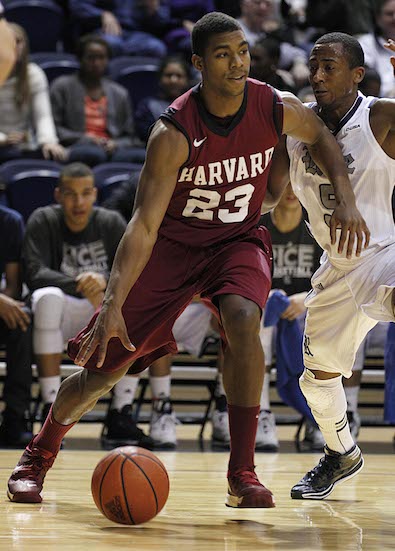
Matt Williams
The 2013-2014 season was a very successful one for a Harvard team that finished 27-5, won its 1st ever NCAA Tournament game, and appears to have emerged as one of the top low major programs in the country. One of the main protagonists of Harvard's rise to prominence has been senior forward Wesley Saunders, who averaged 14.2 points, 3.8 assists, and 4.6 rebounds per-game last season en route to earning All-Ivy League 1st Team honors for the second straight year.
A consensus top-150 recruit coming out of Windward HS (CA), Saunders spurned a number of high major offers to head across the country to play in Cambridge. Measuring 6'5.5 in shoes with a 6'8.5 wingspan and a solid 220-pound frame, Saunders has nice size for a wing player to go along with good strength for his position and solid overall athleticism. Able to play above the rim when given space, Saunders is mostly a below the rim player, but his size and physicality have made him a force in the Ivy League.
Offensively, Saunders is fairly unique commodity at the college level. A savvy, skilled wing who does much of his damage from the midrange in, Saunders is a versatile talent who contributed in a variety of ways for Harvard a year ago. Able to create his own shot off the dribble, make physical plays against smaller players around the rim, and set the table for others, Saunders was often the focal point of a balanced, efficient Harvard attack a year ago.
Despite his size relative to most plays operating in the two man game, Saunders saw most of his possessions handling the ball on the pick and roll a year ago according to Synergy Sports Technology, serving as a secondary ball-handler of sorts within Tommy Amaker's offense. Saunders may not have elite quickness or a lot of shake to his game, but he's a solid ball-handler with very good body control and vision.
There isn't a lot of flash to Saunders' offensive game, but he finds a way to consistently make plays by being decisive and aggressive. Able to use his strength to get the rim, Saunders struggled to finish as consistently last season as he did two years ago, seeing his finishing rate dip from 57% to 47%, but he continued to get to the line at a high rate and made a respectable 76% of his free throws.
An improved jump shooter from when he arrived at Harvard, Saunders made 43% of his perimeter attempts a year ago, the large majority of which came off the dribble and from the mid-post area. Shooting the ball with little elevation but improved touch and follow through, Saunders does a nice job staying on balance, allowing him to get his shot off from a variety of spins and pivots. Knocking down just 27% of his 1.1 3-point attempts per-game, Saunders is a threat from the perimeter, but proving his mettle as a catch-and shoot threat from beyond the arc would be a major addition to his resume from a NBA perspective.
More than just a scorer, Saunders averaged 4.5 assists per-40 minutes pace adjusted while posting the first positive pure point rating of his career as a junior, showing that he can make an impact as a passer as well. Showing a high basketball IQ making the simple play in transition and on the pick and roll, Saunders has a clear understanding of how to get his teammates involved within the flow of the Harvard offense. His unselfishness and decision-making are both impressive.
Defensively, Saunders plays with good energy and fundamentals, but lacks the type of lateral quickness that would give him significant upside on this end of the floor at the next level. A solid rebounder for a wing who does a very nice job reading the ball handler when defending off the ball, Saunders finds himself trailing behind plays a bit more often than he should when his man beats him off the bounce or is working off of screens.
Wesley Saunders is a player to keep an eye on as he looks to repeat as Ivy League Player of the Year. His lack of consistent production as a spot-up shooter raises some questions about how he'd fit in as a roleplayer on the wing at the next level, but his progress as a shooter on the whole a year ago was encouraging even if his shooting at the rim regressed. A prime candidate for the Portsmouth Invitational Tournament, Saunders is a unique player worth keeping an eye on as Harvard figures to be on the best low major teams in the country. December match ups with Virginia and Arizona State will be worth watching in particular, as they'll rank among the biggest tests the Crimson will face until March.
#25 Dwayne Polee, 6'7, Guard/Forward, San Diego State, Senior
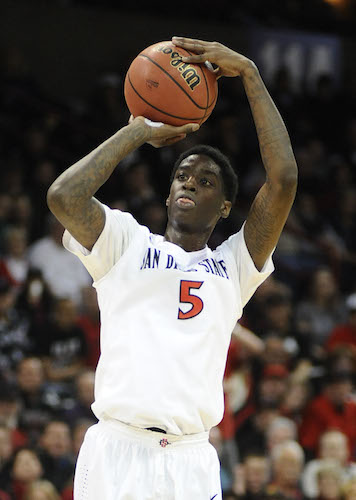
Kyle Nelson
Dwayne Polee logged a solid freshman season at St. John's before transferring to San Diego State. After sitting for a out a year, Polee appeared to take a step back during his sophomore season, playing just nine minutes per game and never really establishing a role in San Diego State's offense. As a junior, Polee struggled with inconsistency for most of the regular season, but emerged as a key player in San Diego State's run to the Sweet 16. His work off of the bench earned him 6th Man of the Year honors in the Mountain West Conference and has contributed to the opinion that he is the key to Aztecs's chances of replicating their postseason success in 2014-2015. With loads of potential, but inconsistent results thus far, just how good is Dwayne Polee II and can he take the next step forward as a senior?
Polee certainly looks the part of an NBA small forward prospect, standing 6'7 with a 7'0 wingspan and a high center of gravity. He is also an elite athlete, both quick in transition and extremely explosive around the basket. He has the agility and second bounce that allow him to make plays all over the floor, and plays with an energy that maximizes his athleticism at this level. That being said and though he has ideal physical profile for either wing position, he will need to add some weight to his rail thin 195-pound frame.
For as intriguing as Polee is in terms of his physical profile, he struggled to consistently translate these advantages into consistent production. Yet, he ultimately finished the season averaging 18.8 points per 40 minutes pace adjusted and, though he spent his junior season coming off of the bench, he injected San Diego State's offense with perimeter shooting and dynamic finishes around the basket. In general, Polee improved in almost every statistical category while posting career marks in shooting efficiency and seeing three times as many possessions as he did during his sophomore season.
65% of his overall field goal attempts were jump shots and he made a respectable 37.9% of these looks. He was particularly effective in a catch-and-shoot capacity where he shot 40.3% and showed consistent NBA range. His shooting mechanics looked good, as well, and Polee shows a fluid shooting motion, a textbook release and high release point, and solid elevation. Additionally Polee had little trouble shooting with a man in his face, a function of his length and athleticism, and should be able to get his shot off at the next level in a variety of situations. That being said, he may want to address his dual tendencies to jump stop into his shooting motion and fall away from the basket, both of which are particularly problematic when he is wide open. At the end of the day, however, he made significant strides as a junior and his 45.7% 3FG over his last 10 games hint at his potential to continue to improve in this area.
Unfortunately, he is neither a very good nor comfortable shooter off of the dribble, which limits his ability to score from mid-range and points to probably his most significant weakness at this stage in his career. Polee's ball handling ability in general leaves much to be desired, as he tends to dribble the ball above his waist and lacks any sort of advanced moves. As a result, when he puts the ball on the floor, he tends to either turn the ball over or take a straight line drive at the basket, which disintegrate relative to how many defenders are in his vicinity. He simply cannot create and, at 22 years old, it remains to be seen just much he can continue to grow as an offensive player.
Most concerning, however, is the fact that Polee is a remarkably below average finisher around the basket and his shooting touch here is extremely suspect. He converted on just 47.7% of his attempts in this capacity, a number that is even less impressive when you remove his highlight reel dunks from consideration. Polee plays with outstanding energy, but playing with more control would probably go a long way in becoming a more efficient scorer.
For as limited as he is on the offensive end of the floor, Polee has the makings of an outstanding defensive player even if he has only scratched the surface of his potential. He has elite lateral quickness, agility and explosiveness and can face guard most players at either wing positions with little trouble. Additionally, his 2.4 steals and 1.4 blocks per 40 minutes pace adjusted are a testament to how his size and length, coupled with his energy, can disrupt play all over the floor. With an eye toward the NBA, he also defends the pick and roll well, particularly given how he scoots over screens and trails his man to the basket when he is beaten. The issue overall is that his awareness seems average: he bites on too many pump fakes, is very foul prone, finds himself out of position, and struggles to close out on shooters, among other issues. His strength will also do him few favors on the defensive end at the next level.
As he is a year older than most in his class, the question remains whether Dwayne Polee II can actually achieve the potential that he has displayed thus far in his career. Though he possesses the ideal physical profile for an NBA wing, his overall game lags behind in ways that may ultimately hinder his chances of getting there. While his perimeter shooting and defensive ability will undoubtedly keep him in the draft conversation as the season progresses, scouts will be looking for him to embrace a larger role in San Diego State's offense as a senior. Last March, Polee averaged 12 points per game while shooting 46.9% 3FG in a stretch that included San Diego State's run to the Sweet 16; one month prior he averaged 4.4 points per game while shooting 39.1% from inside of the arc and 22.2 from beyond. If Dwayne Polee II plays like the former player as a senior, then he will undoubtedly get serious looks from scouts as the season progresses.













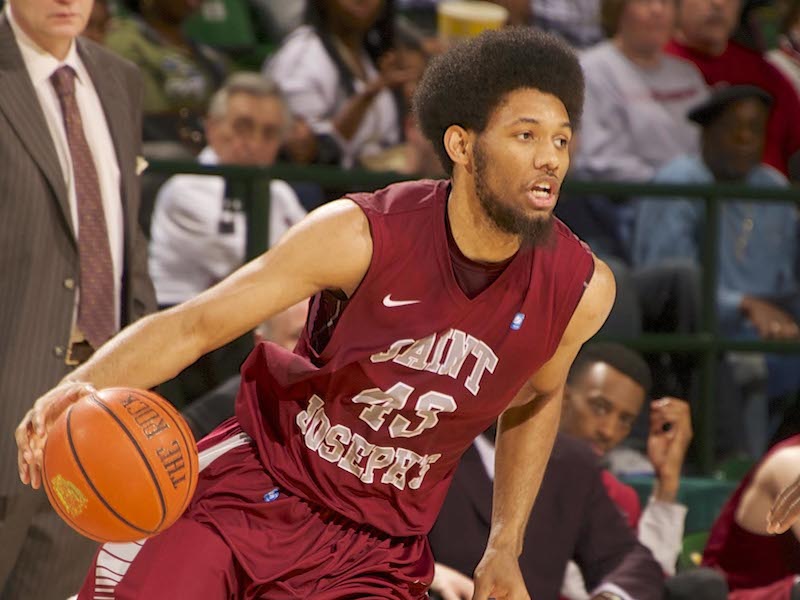









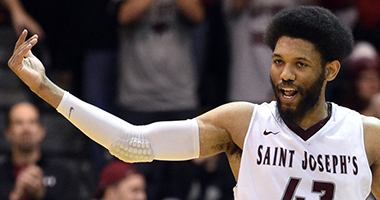





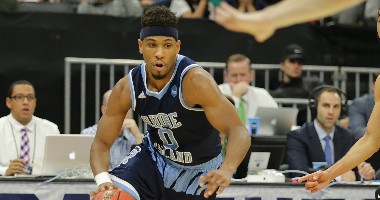








Comments